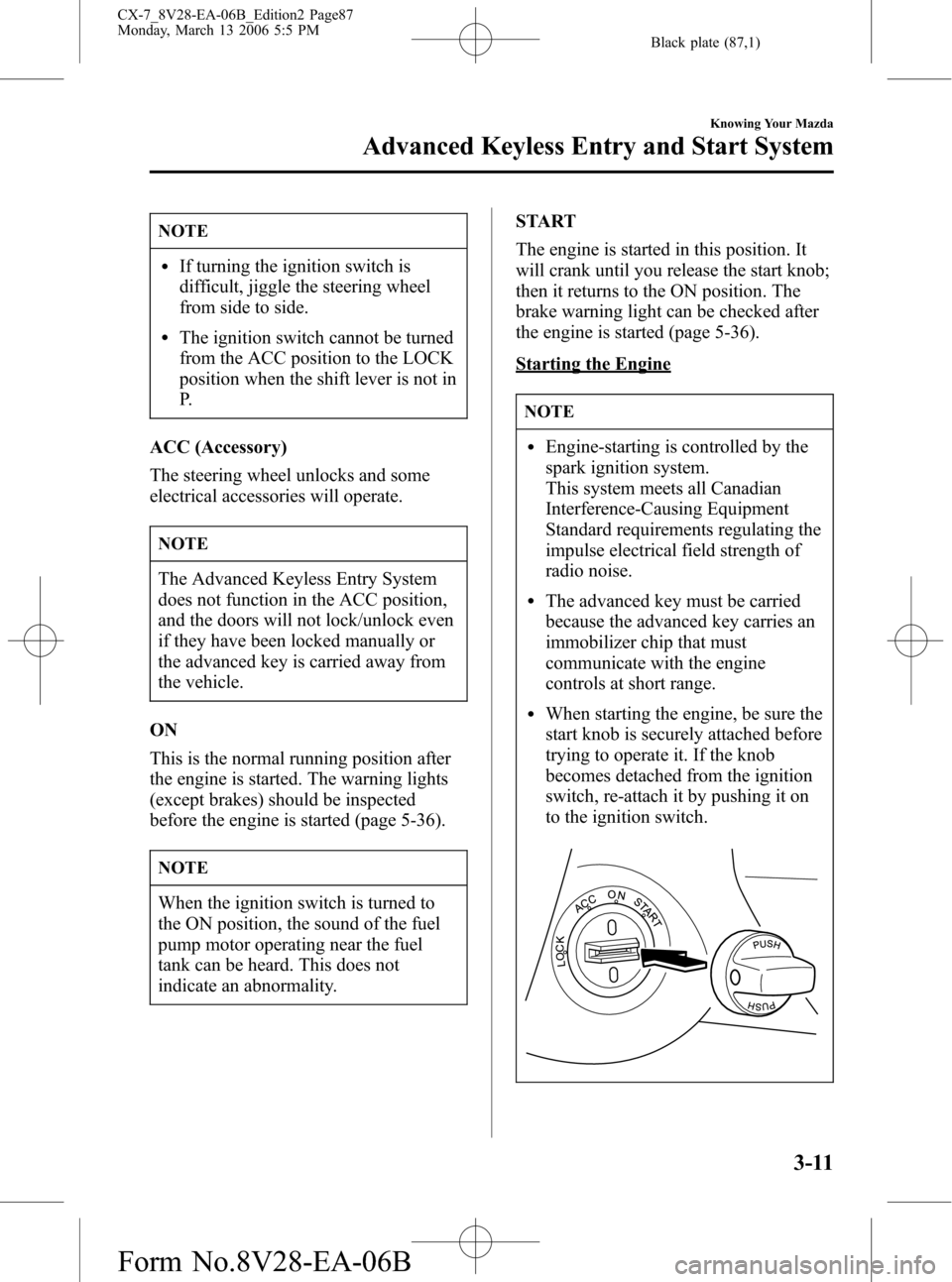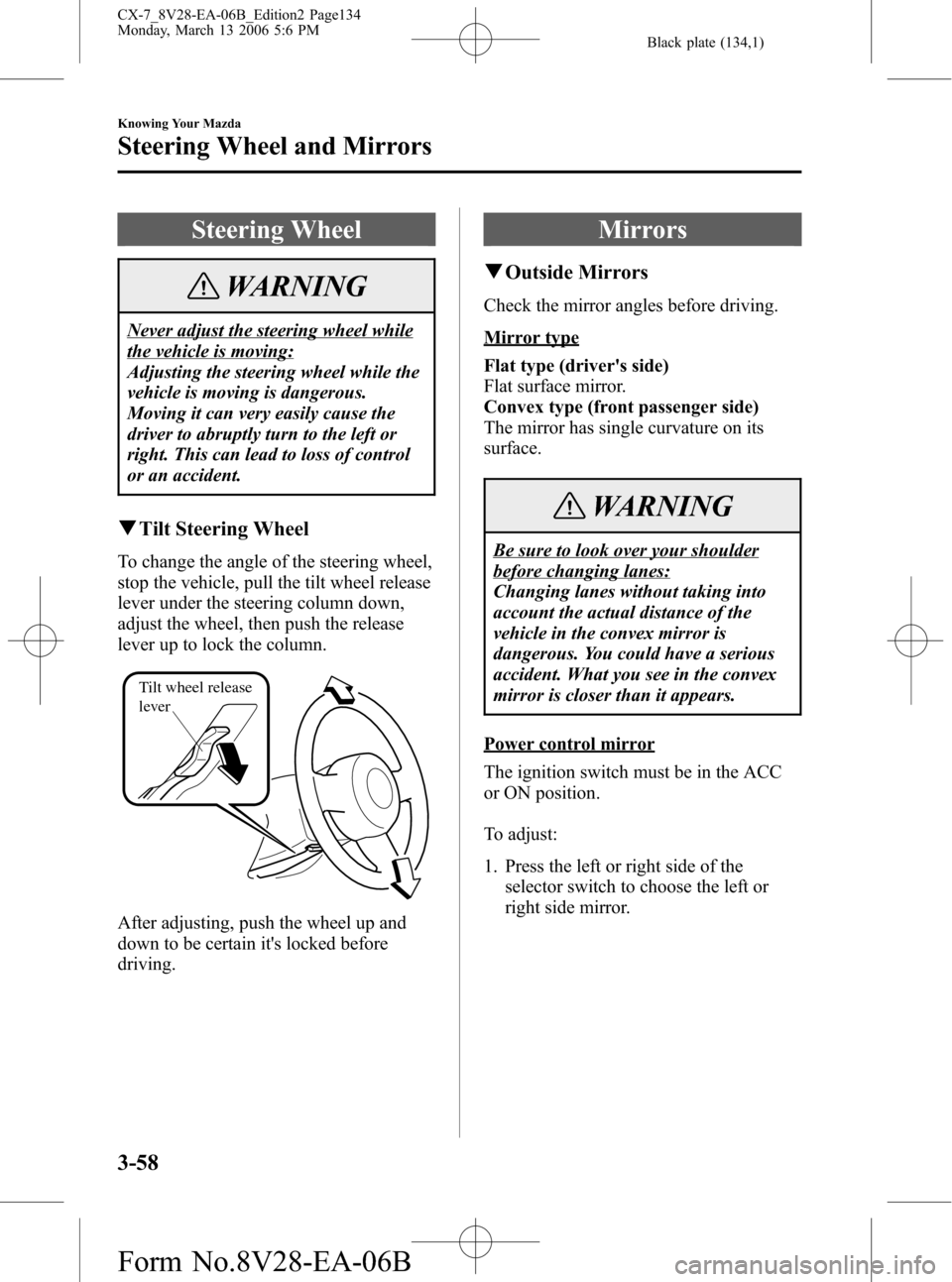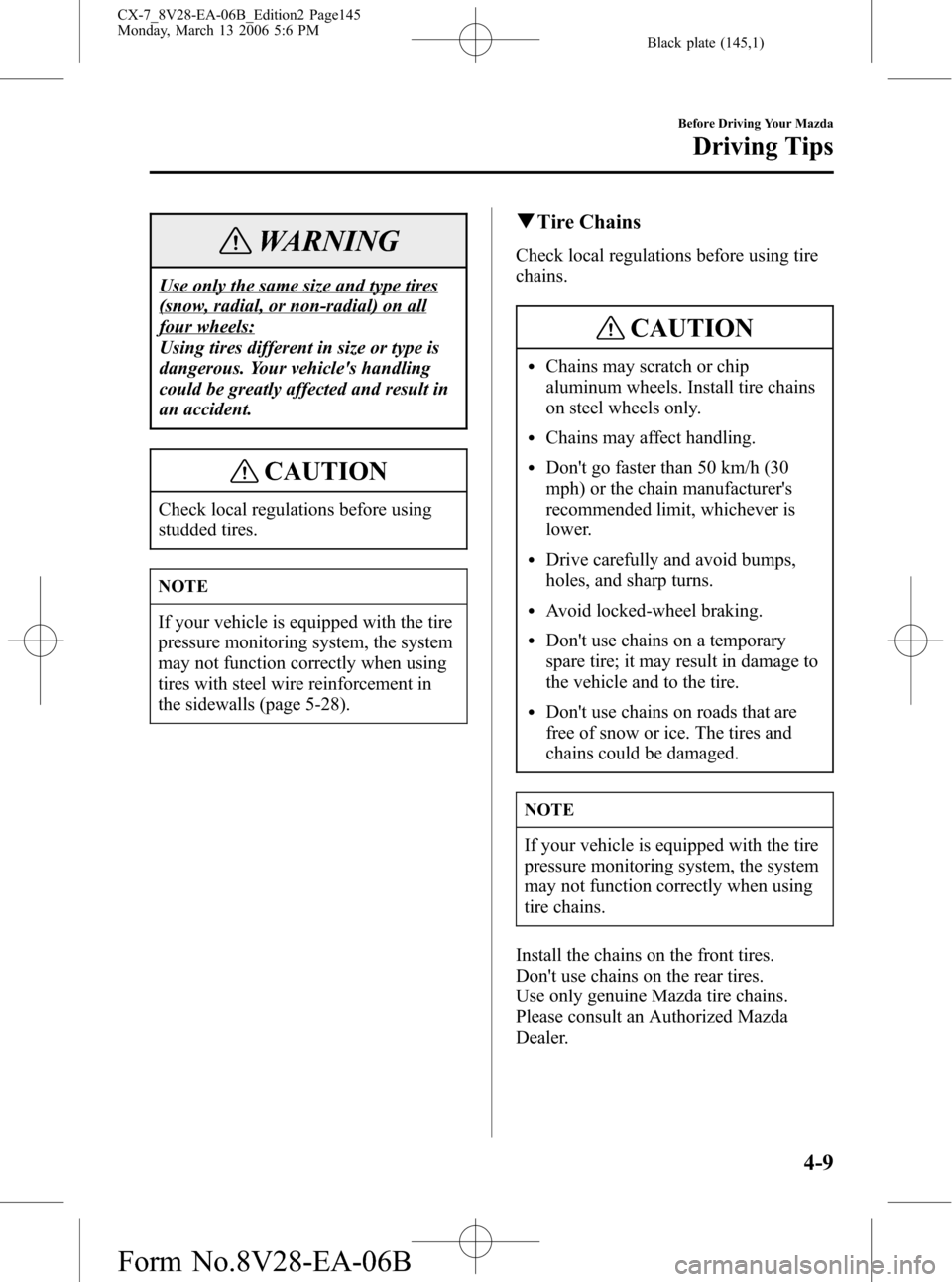wheel MAZDA MODEL CX-7 2007 (in English) User Guide
[x] Cancel search | Manufacturer: MAZDA, Model Year: 2007, Model line: MODEL CX-7, Model: MAZDA MODEL CX-7 2007Pages: 406, PDF Size: 6.11 MB
Page 87 of 406

Black plate (87,1)
NOTE
lIf turning the ignition switch is
difficult, jiggle the steering wheel
from side to side.
lThe ignition switch cannot be turned
from the ACC position to the LOCK
position when the shift lever is not in
P.
ACC (Accessory)
The steering wheel unlocks and some
electrical accessories will operate.
NOTE
The Advanced Keyless Entry System
does not function in the ACC position,
and the doors will not lock/unlock even
if they have been locked manually or
the advanced key is carried away from
the vehicle.
ON
This is the normal running position after
the engine is started. The warning lights
(except brakes) should be inspected
before the engine is started (page 5-36).
NOTE
When the ignition switch is turned to
the ON position, the sound of the fuel
pump motor operating near the fuel
tank can be heard. This does not
indicate an abnormality.START
The engine is started in this position. It
will crank until you release the start knob;
then it returns to the ON position. The
brake warning light can be checked after
the engine is started (page 5-36).
Starting the Engine
NOTE
lEngine-starting is controlled by the
spark ignition system.
This system meets all Canadian
Interference-Causing Equipment
Standard requirements regulating the
impulse electrical field strength of
radio noise.
lThe advanced key must be carried
because the advanced key carries an
immobilizer chip that must
communicate with the engine
controls at short range.
lWhen starting the engine, be sure the
start knob is securely attached before
trying to operate it. If the knob
becomes detached from the ignition
switch, re-attach it by pushing it on
to the ignition switch.
Knowing Your Mazda
Advanced Keyless Entry and Start System
3-11
CX-7_8V28-EA-06B_Edition2 Page87
Monday, March 13 2006 5:5 PM
Form No.8V28-EA-06B
Page 134 of 406

Black plate (134,1)
Steering Wheel
WARNING
Never adjust the steering wheel while
the vehicle is moving:
Adjusting the steering wheel while the
vehicle is moving is dangerous.
Moving it can very easily cause the
driver to abruptly turn to the left or
right. This can lead to loss of control
or an accident.
qTilt Steering Wheel
To change the angle of the steering wheel,
stop the vehicle, pull the tilt wheel release
lever under the steering column down,
adjust the wheel, then push the release
lever up to lock the column.
Tilt wheel release
lever
After adjusting, push the wheel up and
down to be certain it's locked before
driving.
Mirrors
qOutside Mirrors
Check the mirror angles before driving.
Mirror type
Flat type (driver's side)
Flat surface mirror.
Convex type (front passenger side)
The mirror has single curvature on its
surface.
WARNING
Be sure to look over your shoulder
before changing lanes:
Changing lanes without taking into
account the actual distance of the
vehicle in the convex mirror is
dangerous. You could have a serious
accident. What you see in the convex
mirror is closer than it appears.
Power control mirror
The ignition switch must be in the ACC
or ON position.
To adjust:
1. Press the left or right side of the
selector switch to choose the left or
right side mirror.
3-58
Knowing Your Mazda
Steering Wheel and Mirrors
CX-7_8V28-EA-06B_Edition2 Page134
Monday, March 13 2006 5:6 PM
Form No.8V28-EA-06B
Page 135 of 406

Black plate (135,1)
2. Depress the mirror switch in the
appropriate direction.
Outside mirror
Mirror switchSelector switch
After adjusting the mirror, lock the control
by placing the selector switch in the
middle position.
Folding the mirror
Fold the outside mirror rearward until it is
flush with the vehicle.
WARNING
Always return the outside mirrors to
the driving position before you start
driving:
Driving with the outside mirrors
folded in is dangerous. Your rear view
will be restricted, and you could have
an accident.
Mirror defrosterí
To turn on the mirror defrosters, turn the
ignition switch to the ON position and
push the rear window defroster switch
(page 5-58).
qRearview Mirror
Rearview mirror adjustment
Before driving, adjust the rearview mirror
to center on the scene through the rear
window.
Reducing glare from headlights
Do this with the day/night lever in the day
position.
Push the lever forward for day driving.
Pull it back to reduce glare from
headlights.
Night DayDay/Night lever
Knowing Your Mazda
Steering Wheel and Mirrors
3-59íSome models. CX-7_8V28-EA-06B_Edition2 Page135
Monday, March 13 2006 5:6 PM
Form No.8V28-EA-06B
Page 136 of 406

Black plate (136,1)
WARNING
Do not stack cargo or objects higher
than the seatbacks:
Cargo stacked higher than the
seatbacks is dangerous. It can block
your view in the rearview mirror,
which might cause you to hit another
car when changing lanes.
3-60
Knowing Your Mazda
Steering Wheel and Mirrors
CX-7_8V28-EA-06B_Edition2 Page136
Monday, March 13 2006 5:6 PM
Form No.8V28-EA-06B
Page 142 of 406

Black plate (142,1)
Break-In Period
No special break-in is necessary, but a few
precautions in the first 1,000 km (600
miles) may add to the performance,
economy, and life of your Mazda.
lDon't race the engine.
lDon't maintain one constant speed,
either slow or fast, for a long period of
time.
lDon't drive constantly at full-throttle or
high engine rpm for extended periods
of time.
lAvoid unnecessary hard stops.
lAvoid full-throttle starts.
lDon't tow a trailer.
Money-Saving Suggestions
How you operate your Mazda determines
how far it will travel on a tank of fuel. Use
these suggestions to help save money on
fuel and repairs.
lAvoid long warm-ups. Once the engine
runs smoothly, begin driving.
lAvoid fast starts.
lKeep the engine tuned. Follow the
maintenance schedule (page 8-3) and
have an Authorized Mazda Dealer
perform inspections and servicing.
lUse the air conditioner only when
necessary.
lSlow down on rough roads.
lKeep the tires properly inflated.
lDon't carry unnecessary weight.
lDon't rest your foot on the brake pedal
while driving.
lKeep the wheels in correct alignment.
lKeep windows closed at high speeds.
lSlow down when driving in crosswinds
and headwinds.
WARNING
Never stop the engine when going
down a hill:
Stopping the engine when going down
a hill is dangerous. This causes the
loss of power steering and power
brake control, and may cause damage
to the drivetrain. Any loss of steering
or braking control could cause an
accident.
4-6
Before Driving Your Mazda
Driving Tips
CX-7_8V28-EA-06B_Edition2 Page142
Monday, March 13 2006 5:6 PM
Form No.8V28-EA-06B
Page 143 of 406

Black plate (143,1)
Hazardous Driving
qDriving on Slippery Surface
WARNING
Be extremely careful if it is necessary
to downshift on slippery surfaces:
Downshifting into lower gear while
driving on slippery surfaces is
dangerous. The sudden change in tire
speed could cause the tires to skid.
This could lead to loss of vehicle
control and an accident.
So do not rely on ABS as a substitute
for safe driving:
The ABS cannot compensate for
unsafe and reckless driving, excessive
speed, tailgating (following another
vehicle too closely), driving on ice and
snow, and hydroplaning (reduced tire
friction and road contact because of
water on the road surface). You can
still have an accident.
When driving on ice or in water, snow,
mud, sand, or similar hazards:
lBe cautious and allow extra distance
for braking.
lAvoid sudden braking and sudden
maneuvering.
lDo not pump the brakes. Continue to
press down on the brake pedal.
lIf you get stuck, select a lower gear and
accelerate slowly. Do not spin the front
wheels.
lFor more traction in starting on
slippery surfaces such as ice or packed
snow, use sand, rock salt, chains,
carpeting, or other nonslip material
under the front wheels.
NOTE
Use snow chains only on the front
wheels.
qRoll-over
WARNING
Avoid sharp turns, excessive speed and
abrupt maneuvers when driving this
vehicles:
Vehicles with a higher center of
gravity such as utility and AWD
vehicles handle differently than
vehicles with a lower center of gravity.
Utility and AWD vehicles are not
designed for cornering at speeds as
high as passenger cars any more than
low-slung sport cars are designed to
perform satisfactorily under off-road
conditions. Failure to drive cautiously
could result in an increase risk of loss
of vehicle control, vehicle roll-over,
personal injury and death.
Utility vehicles have a significantly
higher rollover rate than other types of
vehicles.
Before Driving Your Mazda
Driving Tips
4-7
CX-7_8V28-EA-06B_Edition2 Page143
Monday, March 13 2006 5:6 PM
Form No.8V28-EA-06B
Page 144 of 406

Black plate (144,1)
Rocking the Vehicle
WARNING
Do not spin the wheels at more than
56 km/h (35 mph), and do not allow
anyone to stand behind a wheel when
pushing the vehicle:
When the vehicle is stuck, spinning
the wheels at high speed is dangerous.
The spinning tire could overheat and
explode. This could cause serious
injuries.
CAUTION
Too much rocking may cause engine
overheating, transaxle failure, and tire
damage.
If you must rock the vehicle to free it from
snow, sand or mud, depress the
accelerator slightly and slowly move the
shift lever from D to R.
Winter Driving
lCarry emergency gear, including tire
chains, window scraper, flares, a small
shovel, jumper cables, and a small bag
of sand or salt.
Ask an Authorized Mazda Dealer to
perform the following precautions:
lHave the proper ratio of antifreeze in
the radiator.
Refer to Engine Coolant on page 8-14.
lInspect the battery and its cables. Cold
reduces battery capacity.
lInspect the ignition system for damage
and loose connections.
lUse washer fluid made with
antifreeze―but don't use engine
coolant antifreeze for washer fluid
(page 8-20).
lDon't use the parking brake in freezing
weather as the parking brake may
freeze. Instead, shift to P and block the
rear wheels.
qSnow Tires
Use snow tires on all four wheels
Don't go faster than 120 km/h (75 mph)
while driving with snow tires. Inflate
snow tires 30 kPa (0.3 kgf/cm
2, 4.3 psi)
more than recommended on the tire
pressure label (driver's door frame), but
never more than the maximum cold-tire
pressure shown on the tires.
4-8
Before Driving Your Mazda
Driving Tips
CX-7_8V28-EA-06B_Edition2 Page144
Monday, March 13 2006 5:6 PM
Form No.8V28-EA-06B
Page 145 of 406

Black plate (145,1)
WARNING
Use only the same size and type tires
(snow, radial, or non-radial) on all
four wheels:
Using tires different in size or type is
dangerous. Your vehicle's handling
could be greatly affected and result in
an accident.
CAUTION
Check local regulations before using
studded tires.
NOTE
If your vehicle is equipped with the tire
pressure monitoring system, the system
may not function correctly when using
tires with steel wire reinforcement in
the sidewalls (page 5-28).
qTire Chains
Check local regulations before using tire
chains.
CAUTION
lChains may scratch or chip
aluminum wheels. Install tire chains
on steel wheels only.
lChains may affect handling.
lDon't go faster than 50 km/h (30
mph) or the chain manufacturer's
recommended limit, whichever is
lower.
lDrive carefully and avoid bumps,
holes, and sharp turns.
lAvoid locked-wheel braking.
lDon't use chains on a temporary
spare tire; it may result in damage to
the vehicle and to the tire.
lDon't use chains on roads that are
free of snow or ice. The tires and
chains could be damaged.
NOTE
If your vehicle is equipped with the tire
pressure monitoring system, the system
may not function correctly when using
tire chains.
Install the chains on the front tires.
Don't use chains on the rear tires.
Use only genuine Mazda tire chains.
Please consult an Authorized Mazda
Dealer.
Before Driving Your Mazda
Driving Tips
4-9
CX-7_8V28-EA-06B_Edition2 Page145
Monday, March 13 2006 5:6 PM
Form No.8V28-EA-06B
Page 146 of 406

Black plate (146,1)
Installing the chains
1. Remove the wheel covers, or the chain
bands will scratch them.
2. Secure the chains on the front tires as
tightly as possible. Always follow the
chain manufacturer's instructions.
3. Retighten the chains after driving 1/2
―1 km (1/4―1/2 mile).Driving In Flooded Area
WARNING
Dry wet brakes by driving very slowly
and applying the brakes lightly until
brake performance returns to normal:
Driving with wet brakes is dangerous.
Increased stopping distance or the
vehicle pulling to one side when
braking could result in a serious
accident. Light braking will indicate
whether the brakes have been affected.
CAUTION
Make sure water does not enter the
vehicle interior or the engine area.
Interior materials could get moldy, and
many electronic devices in the cabin
and the engine could be damaged.
4-10
Before Driving Your Mazda
Driving Tips
CX-7_8V28-EA-06B_Edition2 Page146
Monday, March 13 2006 5:6 PM
Form No.8V28-EA-06B
Page 149 of 406

Black plate (149,1)
Trailer Towing
Your Mazda was designed and built primarily to carry passengers and cargo.
If you must tow a trailer, follow these instructions because driver and passenger safety
depends on proper equipment and safe driving habits. Towing a trailer will affect handling,
braking, durability, performance, and economy.
Never overload vehicle or trailer. Consult an Authorized Mazda Dealer if you need further
details.
CAUTION
Don't tow a trailer during the first 1,000 km (600 miles) of your new Mazda. If you do,
you may damage the engine, transaxle, differential, wheel bearings, and other power
train components.
qWeight Limits
TTW and GCWR
The total trailer weight (TTW), gross combined weight rating (GCWR), gross axle
weight rating (GAWR), trailer load, and trailer tongue load must be within the
prescribed limits.
lThe total trailer weight (TTW) is the sum of the weights of the trailer load (trailer
weight plus cargo), trailer hitch, vehicle passengers, and vehicle load. Never allow
the total trailer weight (TTW) to exceed specifications in the Trailer Towing-Load
Table.
lThe maximum GCWR is the combined weight of the trailer and load plus the
towing vehicle (including trailer hitch, vehicle passengers, and load). It must not
exceed specifications in the load table.
GAWR and GVWR
Don't exceed front and rear GAWR (gross axle weight rating) and GVWR (gross vehicle
weight rating). If you do, vehicle handling, braking, and performance will be affected.
These values are also on the Motor Vehicle Safety Certification Label posted on the driver's
door frame.
High-altitude operation
In a high-altitude operating environment, a gasoline engine loses power at a rate of 3% to
4% per 304 m (1,000 ft) of elevation. In these conditions, a reduction in gross vehicle
weight and gross combined weight is recommended.
Before Driving Your Mazda
Towing
4-13
CX-7_8V28-EA-06B_Edition2 Page149
Monday, March 13 2006 5:6 PM
Form No.8V28-EA-06B